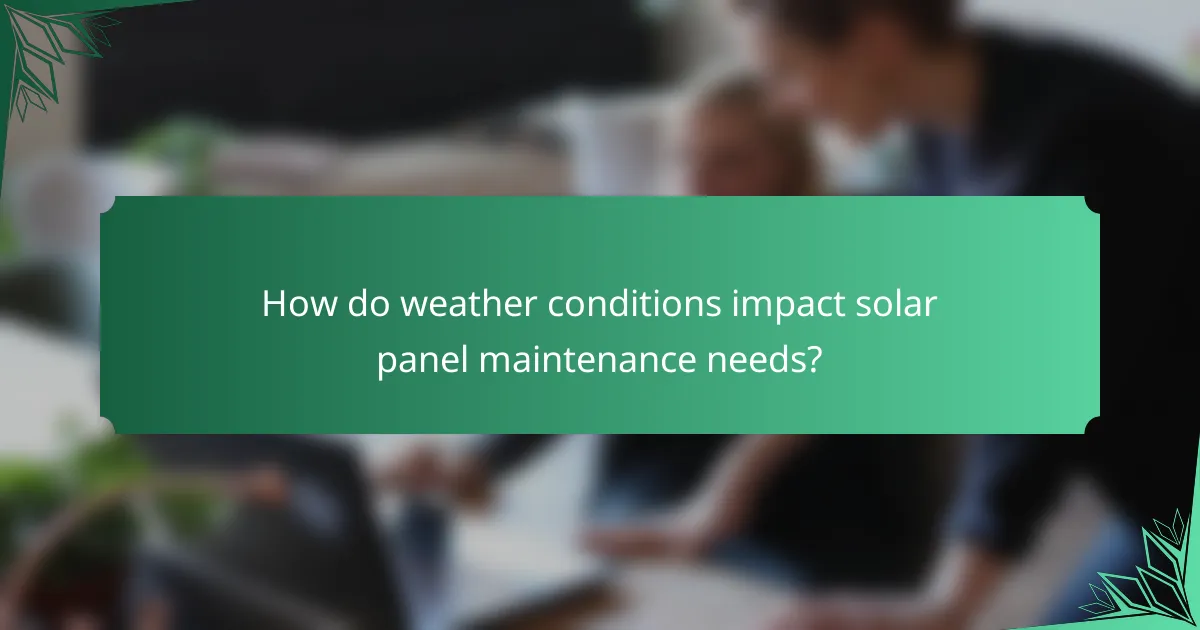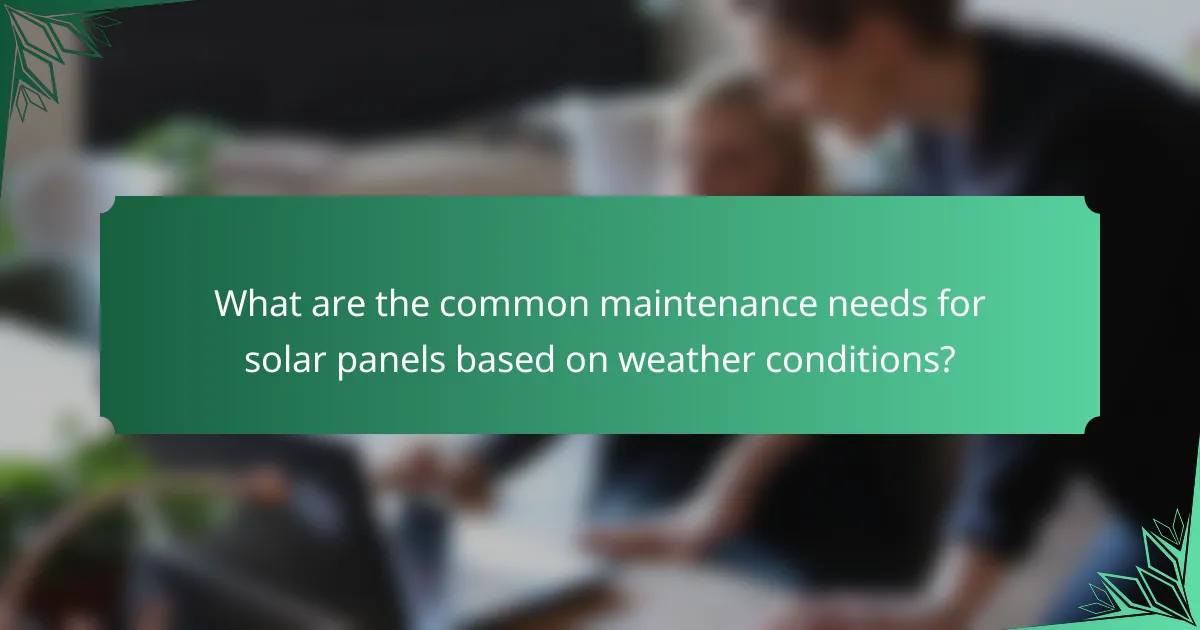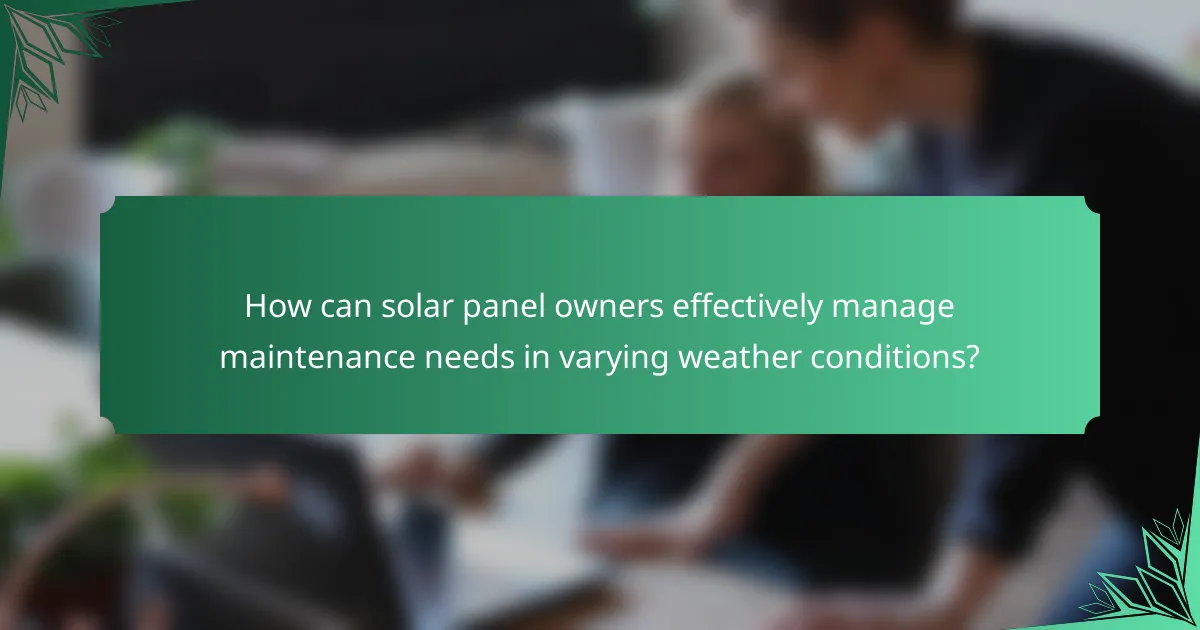
How do weather conditions impact solar panel maintenance needs?
Weather conditions significantly impact solar panel maintenance needs. Rain can help clean solar panels, reducing the need for manual cleaning. However, heavy rainfall may cause debris accumulation, requiring more frequent inspections. Snow can cover panels, blocking sunlight and necessitating removal to maintain efficiency. Extreme temperatures can affect the panel’s performance and longevity, leading to more regular maintenance checks. High winds can cause physical damage or loosen connections, increasing the need for inspections. Overall, varying weather patterns dictate the frequency and type of maintenance required for solar panels.
What specific weather conditions affect solar panels?
Solar panels are affected by several specific weather conditions. High temperatures can reduce the efficiency of solar panels. Conversely, cold temperatures can enhance their performance. Rain helps clean the panels, improving energy output. Snow accumulation can block sunlight, reducing efficiency until it melts. Cloudy days decrease solar energy production significantly. Wind can help cool panels but may also cause debris buildup. Humidity can lead to moisture accumulation, affecting panel integrity. Each of these conditions plays a role in the overall performance and maintenance needs of solar panels.
How does temperature influence solar panel efficiency and maintenance?
Temperature significantly influences solar panel efficiency and maintenance. Higher temperatures generally decrease the efficiency of solar panels. For instance, the efficiency of crystalline silicon panels can drop by about 0.5% for every degree Celsius increase in temperature. This loss occurs because excessive heat can cause increased resistance within the solar cells.
On the maintenance side, elevated temperatures can accelerate wear and tear on components. This includes potential damage to the inverter and electrical connections. Regular maintenance checks become crucial in hot climates to ensure optimal performance. Additionally, dust and debris can accumulate more quickly on panels in high temperatures, necessitating more frequent cleaning.
In conclusion, temperature plays a critical role in both the efficiency and maintenance requirements of solar panels.
What role does humidity play in the upkeep of solar panels?
Humidity can significantly impact the upkeep of solar panels. High humidity levels can lead to moisture accumulation on the panels. This moisture can cause corrosion of the panel components. Corrosion can reduce the efficiency and lifespan of solar panels. Additionally, high humidity can promote the growth of algae and mold. These growths can obstruct sunlight and decrease energy production. Regular cleaning may be necessary in humid environments to maintain efficiency. Therefore, humidity plays a crucial role in determining maintenance frequency and methods for solar panels.
How do different precipitation types affect solar panel care?
Different precipitation types affect solar panel care by influencing cleaning frequency and potential damage. Rain can naturally clean solar panels, reducing the need for manual cleaning. Snow accumulation requires careful removal to prevent damage and maintain efficiency. Hail can cause physical damage to panels, necessitating inspections and possible repairs. Each type of precipitation has distinct implications for maintenance routines. Regular monitoring after heavy rain or snowfall is essential to ensure optimal performance.
Why is understanding weather conditions important for solar panel owners?
Understanding weather conditions is crucial for solar panel owners because it directly impacts energy production and maintenance needs. Solar panels perform optimally in clear, sunny weather. Cloudy or rainy conditions can significantly reduce their efficiency. For instance, solar panels can lose up to 25% efficiency on cloudy days. Extreme weather events, such as hail or heavy winds, can damage solar panels. Regular monitoring of weather forecasts helps owners anticipate these conditions. This foresight allows for proactive maintenance, ensuring long-term performance. Additionally, understanding seasonal weather patterns aids in optimizing energy usage. Overall, awareness of weather conditions is essential for maximizing solar energy benefits.
What risks are associated with neglecting weather-related maintenance?
Neglecting weather-related maintenance poses several risks to solar panels. First, debris accumulation can block sunlight and reduce energy efficiency. Second, moisture buildup can lead to corrosion of electrical components. Third, ice and snow can cause physical damage to panels. Fourth, extreme temperatures can affect the performance and lifespan of solar equipment. Studies show that regular maintenance can enhance energy output by up to 20%. Therefore, timely weather-related maintenance is crucial to maintain optimal performance and longevity of solar panels.
How can proper maintenance improve solar panel longevity?
Proper maintenance can significantly improve solar panel longevity. Regular cleaning removes dirt and debris that can block sunlight. This ensures maximum efficiency and energy production. Inspections can identify issues like loose connections or corrosion early. Addressing these problems promptly prevents further damage. Additionally, maintaining the inverter and wiring enhances overall system performance. Research indicates that well-maintained solar panels can last 25 years or more. In contrast, neglected panels may fail prematurely. Regular maintenance is crucial for optimal performance and extended lifespan.

What are the common maintenance needs for solar panels based on weather conditions?
Solar panels require specific maintenance based on weather conditions. In areas with heavy rain, regular inspections are necessary to check for water damage. Snow accumulation can block sunlight, so panels should be cleared of snow to maintain efficiency. High winds may cause debris to accumulate, necessitating cleaning to prevent scratches. Extreme heat can lead to overheating, so ensuring proper ventilation is essential. In dusty areas, more frequent cleaning is required to remove dirt that can reduce energy output. Regular checks after severe weather events help identify and address any damage promptly. These maintenance practices ensure optimal performance and longevity of solar panels.
How does extreme weather impact solar panel maintenance schedules?
Extreme weather significantly alters solar panel maintenance schedules. High winds can cause debris accumulation on panels, necessitating more frequent cleaning. Heavy snow or ice can obstruct sunlight and lead to structural stress, requiring inspections after storms. Intense heat may accelerate wear on components, prompting regular check-ups. Additionally, extreme rainfall can lead to water damage, increasing the need for inspections. According to the Solar Energy Industries Association, regions with severe weather may require maintenance adjustments to ensure optimal performance and longevity.
What maintenance tasks are essential after heavy storms?
Inspect solar panels for physical damage after heavy storms. Look for cracks, loose connections, or debris accumulation. Clear any debris like leaves or branches that may obstruct sunlight. Check the mounting system for stability and signs of wear. Ensure that the inverter is functioning properly and free from water damage. Examine electrical connections for corrosion or looseness. Clean the panels with water if dirt or grime is present. Document any damage for insurance claims or repairs. These tasks help maintain optimal solar panel performance post-storm.
How should solar panels be maintained during seasonal changes?
Solar panels should be maintained by regularly cleaning and inspecting them during seasonal changes. Cleaning removes dirt, leaves, and snow that can block sunlight. Inspecting ensures there are no cracks or damage to the panels. In winter, clear snow accumulation promptly to maintain efficiency. In spring and fall, check for debris and clean surfaces to optimize performance. Regular maintenance can increase the lifespan of solar panels by up to 25%. Keeping panels clear of obstructions maximizes energy production throughout the year.
What preventative measures can be taken based on weather forecasts?
Preventative measures based on weather forecasts include securing solar panels and checking for debris. Regular maintenance can prevent damage during storms. Monitoring forecasts allows for timely adjustments, such as tilting panels to reduce snow accumulation. Cleaning panels before predicted rain can enhance efficiency. Installing protective coverings during severe weather alerts can safeguard equipment. Furthermore, ensuring proper drainage around solar installations prevents flooding damage. These measures help maintain optimal performance and prolong the lifespan of solar panels.
How can solar panel owners prepare for severe weather events?
Solar panel owners can prepare for severe weather events by securing their panels and ensuring proper maintenance. Owners should inspect the mounting systems to verify they are tightly fastened. This reduces the risk of panels being dislodged by high winds. Additionally, it is advisable to trim nearby trees to prevent branches from damaging the panels during storms.
Installing surge protectors can safeguard the system from electrical surges caused by lightning. Owners should also check and clean the panels regularly to remove debris that may accumulate during severe weather.
Furthermore, having an emergency plan in place is essential. This includes knowing how to safely disconnect the system if necessary. Following these steps helps ensure the longevity and efficiency of solar panels during extreme weather conditions.
What tools and resources are recommended for weather-related maintenance?
Recommended tools for weather-related maintenance include moisture meters, thermal cameras, and cleaning brushes. Moisture meters help assess water intrusion. Thermal cameras identify hot spots in solar panels, indicating potential failures. Cleaning brushes are essential for removing debris and snow. Resources such as maintenance manuals and weather tracking apps provide guidance. Maintenance manuals offer specific procedures for different weather conditions. Weather tracking apps help schedule maintenance during optimal conditions. Using these tools and resources enhances the efficiency and longevity of solar panels.

How can solar panel owners effectively manage maintenance needs in varying weather conditions?
Solar panel owners can effectively manage maintenance needs by regularly inspecting their systems and adjusting cleaning schedules based on weather conditions. Rain can naturally clean panels, but dust accumulation may require manual cleaning in dry climates. Snow should be cleared promptly, as it can block sunlight and reduce efficiency. Owners should also check for debris like leaves or branches after storms. Monitoring performance through inverter readings helps identify issues quickly. Regular maintenance checks, ideally twice a year, ensure optimal operation. Weather forecasts can guide proactive cleaning and maintenance actions. By staying informed, owners can enhance the longevity and efficiency of their solar panels.
What best practices should solar panel owners follow for maintenance?
Solar panel owners should regularly clean their panels to maintain efficiency. Dust, leaves, and debris can block sunlight. Cleaning should be done every six months or more frequently in dusty areas. Owners should inspect the panels for damage or wear at least twice a year. Checking for loose connections and corrosion is essential for safety and performance. Monitoring the inverter’s performance helps identify issues early. Additionally, it is advisable to trim nearby trees to prevent shading. Keeping the area around the panels clear enhances access for maintenance. Following manufacturer guidelines ensures proper care and longevity of the system.
How often should solar panels be inspected based on weather patterns?
Solar panels should be inspected at least twice a year, particularly after severe weather events. Regular inspections help identify potential damage from hail, heavy winds, or storms. Additionally, areas with frequent dust storms or heavy rainfall may require more frequent checks. Research indicates that proactive maintenance can extend the lifespan of solar panels by up to 25%. Therefore, adjusting inspection frequency based on local weather patterns is essential for optimal performance.
What cleaning methods are safest for solar panels in different climates?
The safest cleaning methods for solar panels vary by climate. In dry climates, using a soft brush or a microfiber cloth with water is effective. This method prevents scratching while removing dust and debris. In wet climates, rain naturally cleans panels, but occasional rinsing with water is recommended if dirt accumulates. Avoid harsh chemicals, as they can damage the panels. In snowy climates, let snow melt naturally; using a soft broom can help remove heavy snow without scratching. Regular maintenance checks are essential to ensure optimal performance across all climates.
What common troubleshooting tips can help with weather-related issues?
Common troubleshooting tips for weather-related issues include checking for debris on solar panels. Regularly inspect panels for dirt, leaves, or snow that can block sunlight. Ensure that all connections are secure and free from moisture. Monitor the inverter for error codes that indicate performance issues. Maintain proper drainage around the solar installation to prevent water accumulation. Schedule routine maintenance checks, especially after severe weather events. Consider installing a weather monitoring system to track conditions. These practices help optimize solar panel efficiency and longevity.
How can owners identify and address weather-induced damage quickly?
Owners can identify and address weather-induced damage quickly by conducting regular inspections of their solar panels. They should check for visible signs of damage, such as cracks or loose connections. Monitoring the performance of the solar system is also essential. A sudden drop in energy production may indicate underlying issues. Owners should document any changes in performance or physical condition. After identifying potential damage, they should contact a qualified technician for a thorough evaluation. Timely repairs can prevent further damage and maintain system efficiency. Regular maintenance checks, especially after severe weather events, are crucial for long-term performance.
What resources are available for solar panel maintenance guidance?
Resources for solar panel maintenance guidance include manufacturer manuals, online tutorials, and industry websites. Manufacturer manuals provide specific instructions for the maintenance of their products. Online tutorials offer visual guidance for cleaning and troubleshooting. Industry websites, such as the Solar Energy Industries Association, provide best practices and maintenance tips. Local solar installation companies often offer maintenance services and guidance. Community forums can also be valuable for sharing experiences and advice. These resources ensure proper upkeep of solar panels, enhancing their efficiency and lifespan.
The main entity of the article is solar panel maintenance. The article explores how various weather conditions, including temperature, humidity, and precipitation types, influence the maintenance needs of solar panels. It highlights the impact of specific weather patterns on efficiency, the importance of regular inspections and cleaning, and the risks associated with neglecting maintenance. Additionally, it provides best practices for managing maintenance schedules based on weather forecasts and outlines essential tools and resources for effective upkeep. Understanding these factors is crucial for solar panel owners to ensure optimal performance and longevity of their systems.